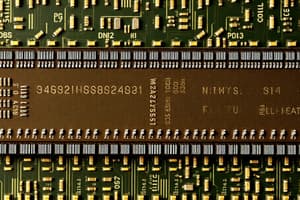Podcast
Questions and Answers
What is the primary purpose of virtual memory?
What is the primary purpose of virtual memory?
Contiguous allocation can lead to external fragmentation.
Contiguous allocation can lead to external fragmentation.
True
What is the primary function of the page replacement algorithm?
What is the primary function of the page replacement algorithm?
To determine which page to remove from memory when new pages need to be loaded.
In memory management, ________ refers to an increase in the amount of hardware memory by using disk space.
In memory management, ________ refers to an increase in the amount of hardware memory by using disk space.
Signup and view all the answers
Match the following memory management concepts with their descriptions:
Match the following memory management concepts with their descriptions:
Signup and view all the answers
Study Notes
Memory Management
- Logical address space: Refers to addresses used by the program.
- Physical address space: Addresses used by the hardware. A mapping is needed between these to access memory correctly.
- Swapping: Moving processes between RAM and secondary storage (e.g., hard drive). Used when RAM is full. Swapping a process to secondary storage frees up RAM.
- Contiguous allocation: Assigning blocks of contiguous memory to processes. Simple to implement, can lead to external fragmentation.
- Paging: Dividing memory into fixed-size blocks (pages) and processes into page sized blocks; use page tables for mapping. Solves external fragmentation, but introduces internal.
- Segmentation: Dividing memory into variable-sized blocks (segments) based on logical program structure. Reduces internal fragmentation, but management can be complex.
Virtual Memory
- Demand paging: Loading pages into memory only when needed (on demand). Reduces the amount of memory immediately required by the process.
- Performance of demand paging: Depends on the page fault rate (how often a page is not loaded). A high fault rate can severely slow down performance.
- Page replacement: The algorithm used to select pages to remove from memory when a new page is needed. A crucial part of demand paging.
- Page replacement algorithms: Strategies for choosing pages to replace, including LRU (Least Recently Used), FIFO (First-In First-Out), and others—each with trade-offs in terms of performance and complexity.
- Thrashing: A phenomenon where the system spends more time swapping than executing. High page fault rate as a process constantly loads and unloads parts of its memory. Causes severe performance degradation.
Studying That Suits You
Use AI to generate personalized quizzes and flashcards to suit your learning preferences.
Description
This quiz covers essential concepts of memory management and virtual memory, including logical and physical address spaces, swapping, and various allocation techniques. Understand key terms like paging, segmentation, and demand paging to reinforce your knowledge. Test your grasp of how these concepts work together to optimize system performance.




